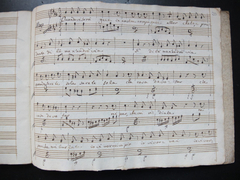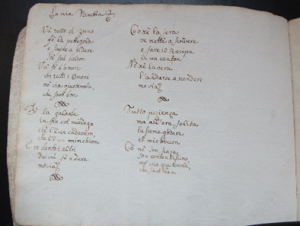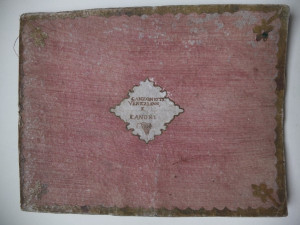Canzonette veneziane
Richard Andrewes
Thursday, October 25, 2018

This post originally appeared on the MusiCB3 Blog of Cambridge University (CC-BY):
Last October the second hand and antiquarian music dealer Travis & Emery circulated their occasional antiquarian music catalogue Sarum no. 58. One item caught my eye because in the last year or so I had updated the online records for two collections of Venetian popular songs – i.e. songs in the Venetian dialect.
70613. Canzonette Veneziane: Canzonette Veneziane, e Canoni. [Voice and bass accompaniment]. Oblong folio (22 x 29cm). 22 folios. Sewn in pink carta rustica with gilt paper edgings and decorations, manuscript paper title-label. Copyist’s manuscript in brown ink on 10-stave paper, with texts (verses) to the works on the opening four folios (unstaved). Contains: La mia Ninetta; Oh bella Nice; Putte vardeme inciera; Ogni donna; Amor Pettegola; Quel bianco sen de latte; Cento Basetti su quei occhietti. [Italy: c.1775]. £500
Both collections I had worked on are in manuscript. One is in the University Library (MS.Add.9324.14) and contains 49 songs, and the other is in the Fitzwilliam Museum (MU.MS.130) and contains a collection of 50 ‘Canzonette Composte dal Sigr.e Angelo Collonna’. The second of these is extremely unusual in that very, very few songs in the Venetian dialect are ascribed to any composer even to one as unknown as Angelo Colonna (a spelling found on some minuets by the same composer in the same manuscript, and the usual spelling of this surname). However a search of the RISM database of the first line of the first song in the Travis & Emery manuscript, “La mia Ninetta” (as a phrase in inverted commas) revealed a surprising result:
https://opac.rism.info/metaopac/start.do?View=rism
(Sorry, no hot links to search results, so copy and paste (including the inverted commas) “La mia Ninetta” into the search box and press return – and have a look at the 16 vocal pieces by Mattia Vento).
Surprise, surprise, six of the titles listed in the Travis & Emery catalogue appear in almost the same order (missing Oh bella Nice, and placing Putte vardeme inciera third instead of at the end) as this manuscript in the British Library ascribed (in RISM) to Mattia Vento:
16 songs for voice and harpsichord La mia Ninetta / Ogni donna / Amor pettegolo / Quel bianco sen / Cento basetti / Putte vardeme / Se ghe amor / Le donne gha un tesoro / Tutti va in colera / A variar l’e un gusto matto / Venezianella / Cornetti, cornettini / E spagnuoli e Siciliani / Quando sono tenerelli / Me tira a cantuzzarte / Quando vi sara gente
This was intriguing enough to warrant acquiring the manuscript.
After it arrived it was given the number MS.Add.10246, was fully catalogued and a fair amount of research done to establish if the music was the same as the British Library manuscript (alas the RISM entry lacks musical incipits so we could not be certain without going down to the British Library and looking at the original).


The comparison confirms that every item in our manuscript is also in the British Museum manuscript (Add.31758), and that the music is virtually identical. Our manuscript has a cover title “Canzonette veneziane e Canoni”, and the British Library has a title page “Ariette veneziane e duetti”. Our manuscript has 12 cazonette/ariette (for voice and unfigured bass) and six duetti (for two voices either with or without unfigured bass), followed by two operatic arias in short score (voice and bass) (‘Quando vi sara gente’ and ‘Una piccolo bambinella’), while the British Library’s has the same 12 ariettas followed by 12 duets and songs, the first six duets of which are the same as in Cambridge. These are followed by two versions (short score on two staves for Alto in E major, and full score for Alto and string orchestra in A major) of Cambridge’s first opera aria (“Quando vi sara gente” which is for Tenor and bass in A major).

None of the ariette or duetti in Add.31758 are ascribed except the last item. The full score of the aria “Quando vi sara gente”, is ascribed “In S. Moise 1763 – Del Sigr. Mattia Vento”.
It so happens that back in 1993 the UL acquired a major collection of microfilms of “Venetian opera libretti : a microfilm of Raccolta de’ drammi : a collection of 1,286 opera libretti held by the University of California, Los Angeles”, which is a chronological collection of libretti published between 1638 and 1769. And there in the volume for 1763 was a libretto for L’egiziana performed in the Teatro San Moise with music by Mattia Vento, and in Act 2 scene 7 the text of the aria “Quando vi sara gente”, thus doubly confirming the ascription.
Alas, the attribution of the ariettas and duets to Mattia Vento in RISM, derived from the 1908 Augustus Hughes-Hughes Catalogue of manuscript music in the British Museum, is not correct.* Though all the ariettas are anonymous, some of the duets are ascribed elsewhere (in the RISM database) to Nicolo Jomelli and Filippo Ruge.
The last item in the Cambridge manuscript is the song/aria “Una piccola bambinella” which is also rather interesting, even though it lacks the last page (see image).
The inclusion of the very rare word ‘bambinella’ is rather fortunate, and a quick search of the RISM database brings up only three items, one of which the third is a concordance (with musical incipit) of our aria.
https://opac.rism.info/metaopac/start.do?View=rism
(Again no hot link to the search results, so just type bambinella in the search box and press return. Switch to ‘English’ at the top right corner if that helps)
It turns out to be an aria from a comic opera by Baldassare Galuppi to a text by Carlo Goldoni, two of the most important and prolific Venetian composers and writers of the mid-18th century. It is from the opera I bagni d’Abano that was performed at the Teatro San Samuele in February 1753.
Though Galuppi’s music was popular and spread round Europe fairly widely, Vento’s operas are less likely to have had very much exposure after the first performances. It is therefore reasonable to assume that both the London and Cambridge copies of these collections date from soon after 1763. There is nothing in either manuscript (paper quality, watermark or copyist hand) that strongly suggests a later date.
Richard Andrewes
*Note from RISM: This has been clarified in the RISM records.
Share Tweet EmailCategory: Library collections

